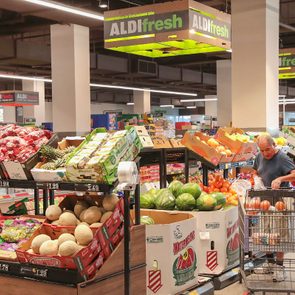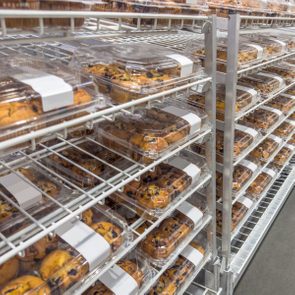The explanation will make you wonder why cashiers at all stores aren't sitting

Here’s Why Aldi’s Cashiers Stay Seated Behind the Cash Register

Aldi is a beacon for anyone who wants to save on groceries, but the retail chain isn’t without its quirks. Those oversized barcodes alone are a head scratcher. And if you’re used to picking up a rotisserie chicken while quietly enjoying some sick ’90s beats, well, Aldi doesn’t play music either. So if you’ve ever wondered why Aldi cashiers are always seated during the entire checkout process, you’re in good company.
In the U.S., most any retail employee ringing you up in a checkout line is standing. So either you don’t even notice that Aldi’s cashiers are sitting or you’re wondering, “What’s the deal?” Well, there are some really interesting factors at play with this decision by the grocer, and we’re going to get into all of them. Read on to find out what they are.
Get Reader’s Digest’s Read Up newsletter for more news, humor, cleaning, travel, tech and fun facts all week long.
Why do Aldi’s cashiers stay seated?
“In grocery retail—especially in European, Asian and some American discount chains like Aldi, Lidl or Daiso—cashiers are often seated at the register for strategic reasons,” says Joshua Domston, talent acquisition manager at Titan Security Group. “For one, sitting reduces physical fatigue, especially during long shifts. And a seated cashier can scan items faster with fewer body movements.”
All in all, this maintains higher productivity throughout a shift without burnout. And there’s actually scientific research to back up the idea that retail ergonomics proves cashier fatigue can impact the scan rate speed.
Additionally, Aldi is a German company. According to Domston, German labor unions and occupational health policies specifically recommend seating for cashiers whenever feasible.
How many items are the cashiers expected to ring up per hour?

“At Aldi, cashiers are expected to scan items extremely fast, averaging 1,000 or more items per hour,” Domston says. “This is only sustainable from a seated position.”
Again, you have to keep in mind that Aldi is a German company and that European point-of-sale terminals (i.e. checkout screens) often incorporate conveyor belts or bagging tables to reduce the physical strain of both the cashier and the customer.
Domston notes that everything at Aldi is optimized for reachability. This includes scanners, screens, bagging areas and cash drawers.
“They’re designed for high-throughput, especially in low-margin, high-volume models like Aldi, where the system is built for speed and minimal customer interaction time,” he says.
Do the cashiers like this policy of staying seated?
Across Reddit, Aldi employees seem less focused on the policy of staying seated and more focused on the speed at which they must scan items. But even then, depending on the store manager, many don’t find an issue with it.
“While we do get measured by these metrics at our store, the only time someone gets a talking-to is when they’re actually underperforming,” says an Aldi employee on Reddit. “I’m sure you know the kind of employee I’m talking about, who has no sense of urgency. And personally, I love our system. I like to compete with myself and my co-workers to see who is fastest, who gets the most compliments, who can throw a pallet in 15 minutes.”
But another Aldi employee admits that many cashiers, even while seated, cannot ring more than 900 items per hour.
“Managers just tend to keep them off the registers unless absolutely necessary,” says the Redditor. “As for management penalizing you for things you have no control over, that is absolutely true. It’s one of the things I don’t like about working at Aldi.”
What’s the benefit for the customer?
Ideally, according to Domston, this operational model helps discount and efficiency-focused chains because it standardizes the customer experience. It also reduces the need for frequent employee breaks, hence lowering staffing costs, and gets shoppers in and out of the store faster, so they can continue with their day.
Whether this strategy saves the consumer money is more of a stretch. It’s possible that by providing a more ergonomic experience for cashiers as a way to be speedier, the store may get by with fewer employees, which then, by default, would help Aldi keep prices low.
RELATED:
About the experts
|
Why trust us
At Reader’s Digest, we’re committed to producing high-quality content by writers with expertise and experience in their field in consultation with relevant, qualified experts. We rely on reputable primary sources, including government and professional organizations and academic institutions as well as our writers’ personal experiences where appropriate. We verify all facts and data, back them with credible sourcing and revisit them over time to ensure they remain accurate and up to date. Read more about our team, our contributors and our editorial policies.
Sources:
- Joshua Domston, talent acquisition leader for Titan Security Group
- Ergonomics: “Effects of sitting versus standing and scanner type on cashiers”
- Reddit: “PSA: Aldi cashiers are timed and scored … on everything”
- Reddit: “Question for past and present cashiers at Aldi. Or, customers can comment too. What do you think of the Total Items Scanned/ Active Work Time (IPH) Standards for cashiers?”



